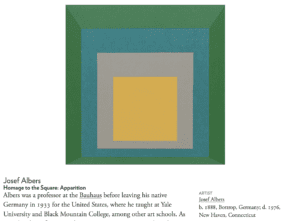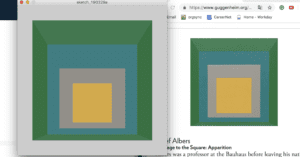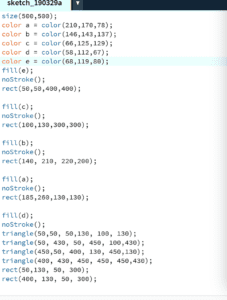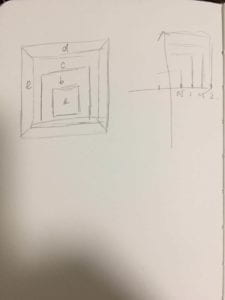Partner:Linhui
The original inspiration of our project comes from the wearable fitness tracker which is able to keep tracking people’s heart rates and footsteps. People can benefit from this equipment by recording the daily data of their activities. However, when we think of the process that the fitness tracker achieves from reading people’s biological data, we realize that there is not enough practical feedback. In other words, people can only see the outcome of the visualization of their inside state, however, the second level of feedback remains absence. We hope that we can create a project that both show the inside statistical information and further accordingly solutions. We hope that we can design a set of projects which includes both the statistical data like fitness tracker and also functions can change the present emotional states of users. However, the problem is that we did not have comprehensive research before we started working on our project. There is another artist named Masakazu Takasu who already has similar projects published before. However, we do not know him until professor Rodolfo Cossovich tells us. Takasu has a project which is a hair clasp with cat ears on it and they will move to different directions according to people’s emotions. Even though we do not intentionally refer to Takasu’s ideas, we still borrow some concepts from him.
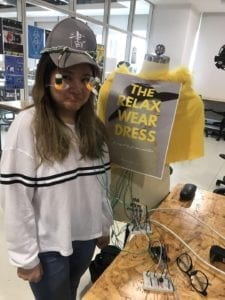
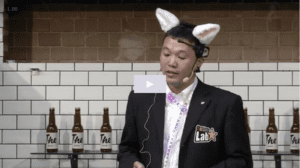
We choose the heart rate sensor between it and a vibration sensor as an input port which sends the data to the computer for further analysis. Compared with the vibration sensor, the heart rate sensor is more sensitive and accurate during the testing. Because of the essential emphasis of the representation of people’s emotional modes in this project, we choose the heart rate sensor instead of the vibration sensor to provide more reliable data. We find the code of the heart sensor on its official website. In order to apply the code to our own project, we have to change the certain value and edit the code again. During this process, we meet lots of challenges because originally we are not familiar with the code of the heart rate sensor. Even though we can refer to its official website for the correct code, it still challenging for us to further re-organize the code and fit them into the concept of our project. In order to correctly input the data from the sensor to the computer, we ask for a lot of help. From this process, we also feel the barriers that people currently face of materializing the consciousness of people’s psychological movements by applying technologies.
Then, by giving a certain order in the code, the external equipment will apply certain actions according to the different amounts of heart rates. For example, different colors of LED will light up to respond to users’ heart rate ranges. Additionally, when users’ heart rates are above a certain amount, two fans will start rotating to cool down the temperature. Normally the fitness tracker only shows the number of users’ heart rate, but we think we need more engaging feedback. Applying the symbolic function of color, people can get more emotional connections by contextualizing themselves into certain circumstances. Moreover, we have another wearable equipment on which we install four motors and add the soft cover. When users’ heart rates exceed a certain amount, the motors start rotating and according to our expectation, this should be able to help users to relax by massaging their acupoints on the back. We hope that this function can work as the secondary interaction that happens between users and the project.
However, during the self-testing process, we find out that the heart rate sensor is highly unstable if it gets affected by external interference when it is reading the data. However, because our project is a wearable project which means we cannot limit people from moving around, so how to get the accurate data while, at the same time, keeping the idea of the wearable project becomes a problem we need to solve. We realize that during the data testing, all the wires cannot be tangled together especially the wire which connects the heart rate sensor with the Arduino, otherwise, the variable will become extremely out of range. Hence, we make a tress using wire which can both fix the fan on the hat and make all wires apart from other equipment.
We got lots of significant feedback from the user testing process. One of our users suggests that we should change the code of the “error message” on the laptop to something funny so that when we meet some technical problem, our users fell less bored. Hence, we change the sign of “error message” to the “You don’t have a heart rate. You are a WALKING DEAD.” This adjustment does change how users feel when they receive feedback from the machine.

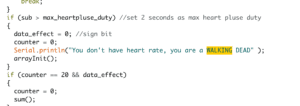
During the users testing process, we install fans on a necklace. However, after analyzing people’s reaction to using it, we decide to change our design into a hat which is less dangerous for users. We also realize that we need to solve the problem of massive wires we use in the project. We should present a tidy project by hiding the circuit into some cover decoration, however, it is really challenging for us to hide all the wires which connect the heart rate sensor with the external equipment. On the one hand, our project is supposed to be convenient to be carried around. However, on the other hand, we cannot apply the function of heart rate testing without all the wires. This is the core struggle that we face during the entire process. Unfortunately, we fail to solve it before the deadline. Consequently, the final appearance of the project does not satisfy our expectation. We realize the reason why wearable equipment is more challenging to accomplish with a certain technique we can manage. Another failure that we should reflect on is the wearable massage equipment. Firstly of all, we did not distribute our effort properly so that we did not have enough time to test all the motors for our massage equipment. The motors we use for the project keep tangling with the cloth and the wires on the back also get broken easily which fail to present the concept of wearable. We also did a lot of research about acupuncture and moxibustion of traditional Chinese medicine to find the accurate acupuncture points which can actually help people to relax, however, because of the individual difference, simply one sample cannot work well on every user.
After our final presentation, I have to admit the fact that I did just less satisfying job. There are many problems both from our ideas of interaction and the actual completeness of our project. The major technical problems I have all listed above, and I think it is necessary to also discuss the problem of developing ideas in the process of our teamwork. We start with a grand brainstorm of our project and even build a 3D model to clarify our ideas.
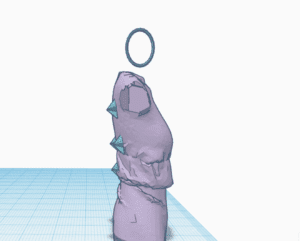
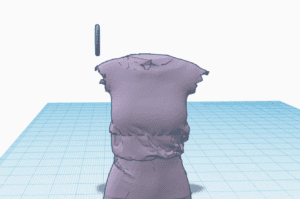
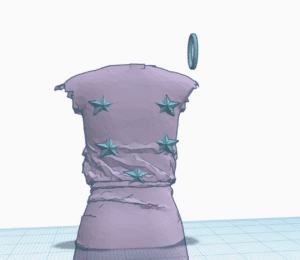
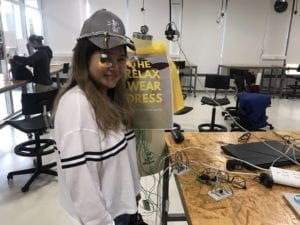
We always have many ideas and are eager to achieve all our ideas according to our imagination. However, the truth is, our ability to manage all the equipment in the lab is not qualified for our requirements. Hence, things turn out to be that we can either change our ideas or compromise with the current situations. This really gives me a lesson on how should we properly organize our ideas and recourses that we have. Since a good project is not simply about the idea but also about the physical appearance that is shown to audiences. If I have more time to work on my project, I probably will take more effort on solving the technical problems we have. I hope that I can make the sensor more stable so that its function process is more fluent. I also hope I can change the design of it so that it can be more visually attractive for users. Additionally, it is also important for me to think of why this project even important to people? Why they need a product to reflect their emotions and also change them? Which part should I emphasize in this project more physical useful or spiritually inspiring? If this project works on helping people with the process of self-reflection, then maybe fans are not necessary. However, if it works on providing functions to release stress and anxiety, then I think I need more efficient equipment like massage motors.
Works Cited
Bill. “Grove – Ear-Clip Heart Rate Sensor.” Seeedstudio, wiki.seeedstudio.com/Grove-Ear-clip_Heart_Rate_Sensor/.
“Masakazu Takasu – Interactive Design from Japan.” Video Archive – The Conference by Media Evolution, videos.theconference.se/masakazu-takasu-interactive-design-from-japan.
